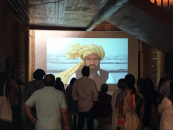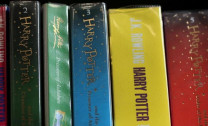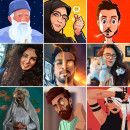World Poetry Day: How the art form is going digital
As poets like Rupi Kaur enjoy a following of millions, here's a closer look at the modern pull of the literary form

"For there is always light, if only we're brave enough to see it. If only if we're brave enough to be it,” writes Amanda Gorman in The Hill We Climb.
Those closing lines by the US poet sounded like a call to action to people witnessing her poised, uplifting performance at the Biden-Harris inauguration on January 20. Her words reminded us that there is a different narrative to feeling entrapped in the doom and gloom of a (former) Trump administration and the grip of a global pandemic.
It was a rallying cry urging us to pick up a pen (or laptop) and see the light; to put faith in democratic ideals and envision a better future.
Poetry unites
Poetry's power in the contemporary world was not lost on UNESCO, when at a General Conference in Paris in 1999 it first adopted March 21 as World Poetry Day.
"Poetry reaffirms our common humanity by revealing to us that individuals, everywhere in the world, share the same questions and feelings," the UNESCO website reminds us.
Poetry among digital natives
The rise of rap music in the 1980s and the onslaught of slam poetry, spoken word and open mike performance events in the 1990s and 2000s demonstrated the interest, especially among young people, in the artistic medium. But the digital developments of the past two decades have been a major boon to poetry, taking it to a whole, new level.
"Young people now have grown up with the internet, smartphones and especially, social media. For them, the internet a place for meeting other poets and poetry lovers around the world," Poetry International director Inez Boogaarts told DW.
"Poetry online has exploded in the past five years, even before the pandemic – from poetry blogs to online platforms to social media,” she noted.
Poetry, social media & democracy
It makes the publication of poetry democratic, because people can self-publish. Also, "for young people, Instapoets are completely normal," Boogaarts punctuated.
Take, for instance, Indian-born Canadian poet and illustrator Rupi Kaur, who enjoys over 4 million followers on Instagram. Considered one of the forerunners of Instapoetry, the now 28-year-old has become a star of the genre. Social media led to her fame, with her self-published poetry catapulting her onto The New York Times bestseller list and having sold over millions of copies worldwide. But it is her online presence that trumps. In 2019, The New Republic called her the "writer of the decade."
She writes and posts, among other things, about the immigrant experience, relationships, femininity and trauma. Her third collection, home body, was published in November 2020, after she moved back to her parents' house during the pandemic.
"Kaur cannily understands the contradiction that we want technology — in this case, a very powerful computer — to connect us to real people. She uses her verse, her drawings, her photographs, to give us persona, which is the next-best thing, and also an age-old poetic technique," The New Republic wrote.
"[Kaur is] onto something: The canonical poetry most likely to endure the next century is the one that can fit comfortably within the glowing window we spend so much of our time gazing into,” the outlet forecasted.
Countless contemporary poets meanwhile post videos of their work on YouTube and Instagram.
Actually reading poetry vs. a poetry event
The popularity of poetry on social media, however, is a far cry from the actual reading of it, says Michael Schmidt, founder and managing director of British publisher Carcanet. Among those of many poets around the world, the house publishes the works of US American Louise Glück, who garnered the Nobel Prize for Literature last year.
"For the poetry reader rather than the poetry enthusiast who goes a certain distance and then is distracted by another fashionable thing (yes, poetry is rather fashionable at present), the experience of poetry is cumulative and slow, and it really can't be usefully accelerated or it becomes diluted," Schmidt told DW.
"We publish for readers. Zoom events have made a difference in terms of the discussion and presentation of poetry. We generally insist that the texts of poems be included in our zooms so the viewer can be a reader and not just a passive listener," he said.
We are not alone
Publishers, especially small ones, and poets around the globe have had to tackle how to stay afloat without large gatherings like readings in auditoriums, without real audiences. It has meant, as in most spheres, communicating primarily on the internet. "But nothing, no online event, can replace a live reading — in person," Thomas Wohlfahrt, director of Berlin's Haus für Poesie (House for Poetry), told DW.
In these trying times, being online has been the next best thing; it has kept us all going. It has been our community. In Rupi Kaur's words from home body, "you are not alone. Alone would be if your heart no longer beat and your lungs no longer pulled and your breath no longer pushed. How are you alone if an entire community lives in you. You have all on your side.”
Have something to add to the story? Share it in the comments below.



















COMMENTS
Comments are moderated and generally will be posted if they are on-topic and not abusive.
For more information, please see our Comments FAQ